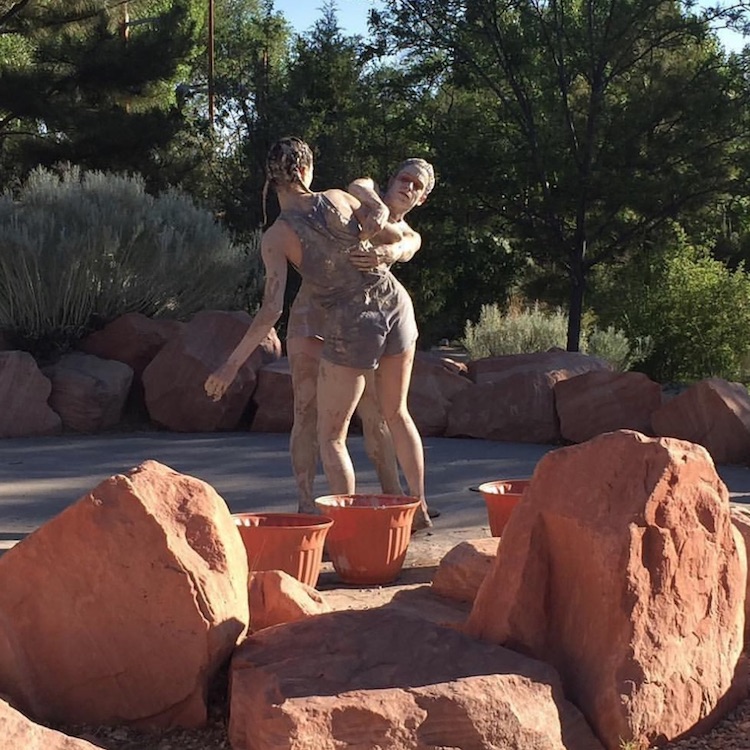SANTA FE — Earlier this June, Santa Fe was treated to a small, but mega-cool, thing featuring a week-long visit from emerging LA-based dance group szalt dance company, who gifted us with a public dance workshop and two performances—the last of which caught Cfile’s eye.
The dancers presented smallstrangething—a site-specific, adaptive and collaborative piece—with Santa Fe-based group Place Projects in the Santa Fe Railyard Park (June 11, 2017).
Drawing on water symbols, unconscious thinking and the desert, the dancers emerged wearing sky blue coveralls bathed in the long rays of evening sunlight. They traversed across the park’s rich, russet-colored terraces surrounded by native New Mexico plants, large boulders and play structures. And in a seemingly ritualistic and mesmerizing manner, they began to dip their hands into terracotta-colored pots, vigorously rub their hands together and cover themselves in slip before embarking on their movement journey.
I was able to take a moment and interview szalt founder Stephanie Zaletel about the smallstrangething collaboration with Place Projects.
Cfile: How did you get to the point of creating smallstrangething? Describe your process for creating work and cultivating space for performance.
Szalt: smallstrangething is the brain-child of Alanna Herrera and Brendan Carn, co-directors of Place Projects. The idea is to create work in non-traditional spaces that awakens curiosity inside of the viewer/whoever is around to see it. Huge thank you to the Santa Fe Railyard Conservancy and Art Project for facilitating the space.
Cfile: What scoring, assuming it was improvisational, drove your performance?
Szalt: For the szalt dancers and I, we pulled from choreography, themes and vocabularies from my most recent works (for stage) WATER STORIES and Marshmallow Sea. We brought water to the desert. The stilt walkers, Alanna Herrera and Alishiya Kapoor, and Brendan Carn (the bassist), and szalt were all on different tracks with our improvised scores, however we felt compelled to interact and be inspired by the other components as often as possible. The goal was to inhabit the environment as these figures.
Cfile: What was the catalyst to use slip and what purpose were you aiming for it serve?
Szalt: This concept came from Alanna. She wanted to make work about the elements we co-habit. We wanted to bring water and desert together, research the co-dependency and also meditate on the dwellers inside of the elements.
Cfile: How did it feel to to remain in the moment of your movement while simultaneously having slip dry, harden and flake off.
Szalt: It felt fantastic. It kept us present physically and emotionally in the work. Shedding skin.
Cfile: Have you performed similar work in other places? If so, can you describe those.
Szalt: We are an adaptive dance company. Despite many of my works originally being intended for theater spaces, we work in galleries more than half of the time, and build site-sensitive/specific works every few months. During the creation of WATER STORIES and Marshmallow Sea we brought improvised and adapted versions of the works to the LA Riverbed, inside people’s homes, and the ACE Hotel Rooftop Pool. It is an important part of our process to experience other environments. Working outside in less-conventional dance spaces forces a heightened awareness. We have to use our bodies differently, take risks, stay present. Plus, it is an opportunity to introduce experimental contemporary dance/performance art to folks that might never buy a ticket to a performance in a theater. We learn so much from these experiences. We love it.
 Szalt and Place Projects’ smallstrangething was the apex of szalt’s Santa Fe stay. Earlier in the week I was able to attend the two-hour-long workshop, in which the company members guided us through mindful exploration of organic movements and sources of internal power to drive and catalyze movement. Emerging from class felt like awakening from a dream-like state and my body didn’t retaliate the following morning.
Szalt and Place Projects’ smallstrangething was the apex of szalt’s Santa Fe stay. Earlier in the week I was able to attend the two-hour-long workshop, in which the company members guided us through mindful exploration of organic movements and sources of internal power to drive and catalyze movement. Emerging from class felt like awakening from a dream-like state and my body didn’t retaliate the following morning.
The company further explains the workshop concept:
B & B is a movement-meditation practice led by Stephanie Zaletel and szalt dance company members utilizing guided improvisation and creative tasks to warm the body and stimulate the imagination. This rigorous practice increases stamina, balance, creative thinking, and flexibility. Inspired by the dancers’ extensive experiences with Gaga, Yoga, Contemporary, and szalt’s repertoire, B & B challenges the mover to work from an intuitive physical state in order to access their physical and mental range.
The experience locked me in for the remainder of the week’s activities, including smallstrangething. Curious and in awe of the authenticity of the dancers’ movements, I dragged some friends to the Center for Contemporary Arts to accompany me in seeing the company’s newly debuted work Marshmallow Sea.
The work, which took place inside the CCA’s Muñoz Waxman Gallery immersed in an ongoing exhibition, featured stunning choreographed phrases of vocabulary which appeared, drifted and dissolved; suspended moments of stillness; and cacophonies of vocalization, which tore apart time masking the lulling sound of rocking ships, bells and found soundscapes by Jonathan Snipes.
It dives beyond linear narrative and submits to dream logic, physical and psychological “exits,” and the natural conservation of sensational memory.
Photography by: Christy Downs
Explore more images and videos of szalt dance and Place Projects on Facebook.
Do you love or loathe this dance work from the worlds of contemporary ceramics and contemporary ceramic art? Let us know in the comments.








Add your valued opinion to this post.